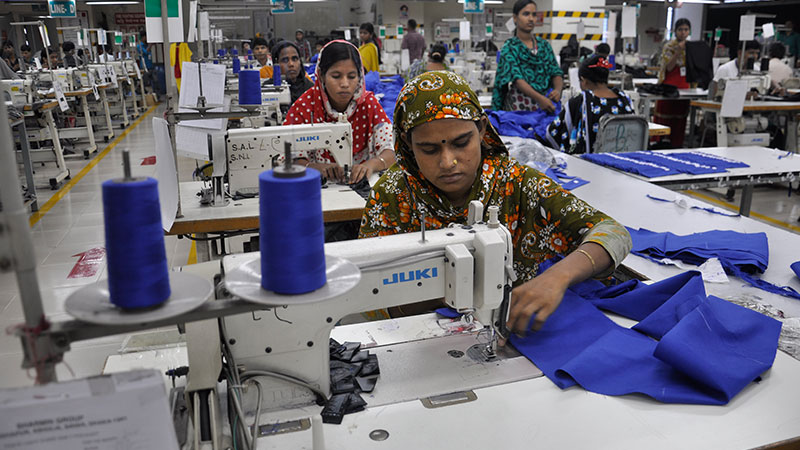 A worker working in a garment factory. File Photo (Bonik Barta)
A worker working in a garment factory. File Photo (Bonik Barta) The eight industrial
zones are home to factories ranging from textiles and garments to mobile
phones, furniture, and leather products. The areas under the jurisdiction of
the industrial police include Ashulia, Gazipur, Chattogram, Narayanganj,
Mymensingh, Khulna, Cumilla, and Sylhet. More than 4.6 million workers are
employed in the factories established in these areas, with 57 percent located
in Ashulia and Gazipur.
Recently, there has been
significant labor unrest in these two areas, leading to the temporary closure
of several factories. Eventually, the factories reopened after the workers'
demands were met. Labor unrest has previously been most intense in Ashulia and
Gazipur. Industrial owners believe that the concentration of most workers in
these areas may contribute to this situation.
Although experts
generally agree that the root cause of labor unrest is not centralization but
deficiencies in the work environment and a lack of civic amenities, they note
that none of the industrial areas are well-planned. During the Pakistani era, planned industrial zones
were established in Tongi and Tejgaon. After that, wherever land was available
on the outskirts of Dhaka, factories for garments and other industries were set
up. The concentration of industries in Ashulia is partly due to its proximity
to the specialized Dhaka EPZ. Alongside unplanned industrialization, the
absence of basic civic facilities and related issues have played a significant
role in intensifying labor unrest in these areas. For instance, while there is
a wage structure for workers, there are no standards for benefits like lunch
and overtime allowances in the factories. Additionally, there are no housing,
recreation, healthcare, or education provisions for workers'
children in Ashulia and Gazipur. They are living there with a lack of minimum
civic amenities.
According to the industrial
police, there are 9473 factories in the eight industrial areas, employing 4.67
million workers. The 4097 factories in Ashulia and Gazipur alone employ 2.68
million workers. This means that 57.38 percent of the total workforce is
concentrated in Ashulia and Gazipur.
Worker representatives
say that although the number of workers in the Ashulia and Gazipur industrial
areas is relatively low, labor unrest still occurs. This is because workers
lack civic amenities in these unplanned areas. No
government has ever paid attention to this issue.
While industrial owners
argue that labor-intensive areas tend to have more problems, the president of
the Bangladesh Garment Manufacturers and Exporters Association (BGMEA),
Khandoker Rafiqul Islam, told Bonik Barta,
"In labor-intensive areas, workers
always face more issues. This is a very normal scenario. Over time, some owners
have moved their factories further away, such as to Ishwardi or Mymensingh.
Many have gone to the far end of Sripur. The situation there is better than in
Ashulia and Gazipur. It doesn't take long for discontent to escalate in
labor-intensive areas."
Regarding the civic
amenities for workers in industrial areas, he said, "Housing
and recreational facilities are not in the hands of individual owners. Many
houses and shops have been built around the factories solely for the workers'
accommodation. Residents have established good income opportunities for
themselves due to the workers. Even matters like recreation are not under the
control of the owners. The government could centrally arrange for parks if they
wanted to. We have long demanded the establishment of proper housing for
workers, but it has not happened."
Labor sector analysts
believe that alongside factories, other employment opportunities are also
needed in these areas. They argue that garment factory owners have dismissed
many workers for various reasons. The factory authorities had established a
system to blacklist these dismissed workers, which they used as a tool.
As a result, workers were dismissed from one factory and struggled to find jobs in
another. Many of these workers continue to live in those areas even after
losing their jobs.
Syed Sultan Uddin
Ahmmed, Executive Director of the Bangladesh Institute of Labor Studies (BILS),
told Bonik Barta, "Without planned industrialization, there is no
chance for change in this situation. Although the owners have made several
initiatives to develop industries in a planned manner, these have not been
implemented. For example, a part of Purbachal could have been developed as a
garment village, but that did not happen. What should now be prioritized is to
enhance civic amenities in areas where industries have developed. This has
become urgent. Workers often sit on the streets when they go out, meaning there
are no park arrangements. Workers live in inhumane conditions in concentrated
areas. It is not unusual for pent-up frustration to build up in such an
environment. Overall, the concentration of workers is giving rise to discontent
because there are no arrangements for a comfortable life. However, the main
issues exist within the factories. Since there are no mechanisms to address
grievances, these issues spill over outside, and the discontent outside is
partly due to unplanned industrialization."
The Director General of
the Department of Factory and Establishment Inspection (Additional Secretary),
Md. Abdur Rahim Khan disagrees that the concentration of workers in these two
areas is a cause of labor unrest. He told Bonik Barta, "I do
not find any justification in saying that the concentration of workers is a
reason for discontent. Rather, ensuring a good working environment is important
by providing workers with their rightful dues and other facilities and amenities."
Following the political
changes brought about by the mass uprising of students and the public, labor
unrest occurred in the labor-intensive areas of Ashulia and Gazipur. Factory
closures disrupted production. In response, workers presented an 18-point
demand to the government and factory owners. After several rounds of
discussions, the owners accepted all of these demands.
The 18-point demands
state that the wage board must be reconstituted to reassess the minimum wage
for workers. Any factories that have not yet implemented the government-declared
minimum salary for 2023 must do so promptly. Labor laws need to be amended.
Suppose a worker is laid off or terminated after completing five years of
service. In that case, they should receive an amount equal to one month’s
basic salary, and provisions in Section 27 of the labor law and other
conflicting sections must be revised.
Among these demands were
calls for the immediate payment of all outstanding wages. The attendance bonus
(BDT 225), meal allowance (BDT 50), and night shift allowance (BDT 100) must be
uniformly increased across all factories. A provident fund system should be
established in all factories. The annual salary increment should be set at a
minimum of 10 percent. A rationing system for workers must be implemented. The
biometric blacklisting controlled by BGMEA should not be allowed, and the
biometric list should be under government control. All harassing and political
cases against workers must be withdrawn. Measures should be taken to end the
dominance of the scrap business, and laws should be enacted if necessary. Equal
employment opportunities must be provided in factories. Compensation and
medical care must be ensured for the martyrs and injured workers of the July
uprising. Following an investigation into the welfare of those affected by the
Rana Plaza and Tazreen Fashions disasters, appropriate measures should be
taken. Day-care centers must be established in all factories according to labor
laws. Unjust layoffs must be stopped. The maternity leave for female workers should
be set at 120 days.
A representative from an
organization working on labor rights stated that accepting the owners'
demands proves the validity of the workers' claims.
Officials from
government agencies overseeing labor conditions believe that being deprived of
their rightful dues intensifies labor unrest. They
noted that the facilities and benefits available in garment factories lack any
specific standards. Some factories
provide a meal allowance of BDT 20, others do not, and some may offer less than
BDT 10. Such minor discrepancies also contribute to labor unrest. A significant
weakness is the absence of specific standards for benefits and allowances other
than wages. It is observed that allowances like meals and overtime vary from
factory to factory and owner to owner, each determining the amounts according
to their discretion.
When asked, a senior official from a government agency, who requested to remain anonymous, said, "Another fundamental issue behind the discontent is the lack of a structured system for workers to express their grievances within the factories, which could facilitate problem-solving. As a result, these issues escalate into significant unrest outside. The 2013 law included provisions for welfare officers responsible for addressing workers' complaints. However, it later became evident that owners used these welfare officers to serve their interests. Among the 4.6 million workers, nearly 2.7 million are in Ashulia and Gazipur. Alongside these 2.7 million, there are an additional 2.7 million people in the surrounding areas. This raises questions about Ashulia and Gazipur's infrastructural capacity. All these factors contribute to the unrest."






